Make: Electronics (29 page)
Authors: Charles Platt

Essential: Heat gun
After you join two wires with solder, you often need to insulate them. Electrical tape, sometimes called insulating tape, is messy and tends to come unstuck. You’ll be using heat-shrink tube, which forms a safe, permanent sheath around a bare-metal joint. To make the tube shrink, use a heat gun, which is like a very powerful hair dryer. They’re available from any hardware supply source, and I suggest you buy the cheapest one you can find. See Figure 3-9.
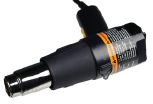
Figure 3-9.
Like an overpowered hair dryer, the heat gun is used with heat-shrink tubing to create a snug, insulated sheath around bare wire.
Essential: Solder pump
This little gadget sucks up hot, melted solder when you are trying to remove a solder joint that you made in the wrong place. Available from All Electronics (catalog item SSR-1) or RadioShack 64-2086. See Figure 3-10.
Essential: Desoldering wick
Also known as desoldering braid. See Figure 3-11. You use this to soak up solder, in conjunction with the Solder Pump. Available from All Electronics (catalog item SWK) or RadioShack (part 64-2090).
Essential: Miniature screwdriver set
Dinky little electronic parts often have dinky little screws in them, and if you try to use the wrong size of screwdriver, you’ll tend to mash the heads of the screws. I like the Stanley precision set, part number 66-052, shown in Figure 3-12. But any set will do as long as it has both small Phillips and straight-blade screwdrivers.
Recommended: Soldering stand
Like a holster for a gun, you rest your soldering iron in this stand when the iron is hot but not on use. Examples are catalog item 50B-205 from All Electronics, RadioShack model 64-2078, or check eBay. See Figure 3-13. This item may be built into the helping hand, but you need an extra one for your second soldering iron.
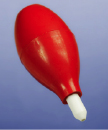
Figure 3-10.
To remove a solder joint, you can heat the solder until it’s liquid, then suck it up into this squeezable rubber bulb.
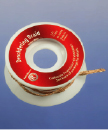
Figure 3-11.
An additional option for removing liquid solder is to soak it up in this copper braid.
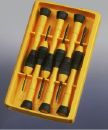
Figure 3-12.
A set of small screwdrivers is essential.
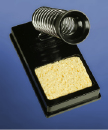
Figure 3-13.
A safe and simple additional stand for a hot soldering iron.
Recommended: Miniature hand saw
I assume that you will want to mount a finished electronics project in a decent-looking enclosure. Consequently, you are likely to need tools to cut, shape, and trim thin plastic. For example, you may want to cut a square hole so that you can mount a square power switch in it.
Power tools are not suitable for this kind of delicate work. A miniature handsaw (a.k.a. a “hobby saw”) is ideal for trimming things to fit. X-Acto makes a range of tiny saw blades. I suggest the #15 blade, plus the handle that it fits in, shown in Figure 3-14. Available online from Tower Hobbies, Hobbylinc, ArtCity, and many other arts/crafts sources. Also look for the larger X-Acto saw blade, #234 or #239, which you can use for cutting perforated board.
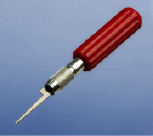
Figure 3-14.
X-Acto makes a range of small saw blades that are ideal for cutting square holes to mount components in plastic panels.
Recommended: Miniature vise
A miniature vise can do things that the helping hand cannot. I use mine when I’m sawing small pieces of plastic and as a dead weight to anchor a piece of perforated board while I’m working on it. See Figure 3-15.
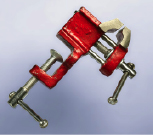
Figure 3-15.
This one-inch vise is available from the McMaster-Carr catalog.
Look for a cast-iron vise that is listed as being 1 inch or slightly larger, available from Megahobby, eBay, and other arts/crafts sources. Also consider the PanaVise, which has a tilting head to allow you to turn your work to any angle.
Recommended: Deburring tool
A deburring tool instantly smoothes and bevels any rough edge (when you have sawn or drilled a piece of plastic, for instance) and also can enlarge holes slightly. This may be necessary because some components are manufactured to metric sizes, which don’t fit in the holes that you drill with American bits. Your small local hardware store may not stock deburring tools, but they are very inexpensively available from Sears, McMaster-Carr, KVM Tools, or Amazon. See Figure 3-16.
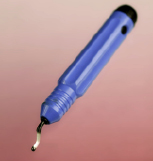
Figure 3-16.
This cunning little blade, safety-tipped with a round bump on the end, removes rough edges from saw cuts with a single stroke, and can enlarge holes that are almost big enough—but not quite.
Optional: Hand-cranked countersink
You need a countersink to bevel the edges of screw holes to accept flat-headed screws. If you use a countersink bit in an electric drill, it won’t give you precise control when you’re working with thin, soft plastic.
Handheld countersinks that you grasp and turn like a screwdriver are easy to find, but McMaster-Carr (catalog item 28775A61) is the only source I’ve found for a hand-cranked tool that is much quicker to use. It comes with a set of bits, as shown in Figure 3-17.
Optional: Pick and hook set
Made by Stanley, part number 82-115, available from Amazon and hardware stores. You can find imported imitations for a few dollars less. See Figure 3-18.
Optional: Calipers
These may seem like a luxury, but are useful for measuring the external diameter of a round object (such as the screw thread on a switch or a potentiometer) or the internal diameter of a hole (into which you may want a switch or potentiometer to fit).
I like Mitutoyo calipers, and the low-end model 505-611 (shown in Figure 3-19) does everything I need. You can find cheaper brands, but economizing on precision measuring tools may not be a wise policy in the long term. The manufacturer’s site will show you all their available models, after which you can Google “Mitutoyo” to find retail sources.
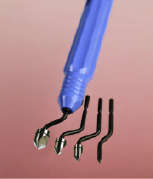
Figure 3-17.
You spin this countersink tool like a hand crank to add just the right amount of bevel to a hole, so that it will accommodate a flat-head screw.
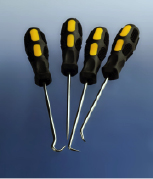
Figure 3-18.
This pick-and-hook set is useful in many unexpected ways.
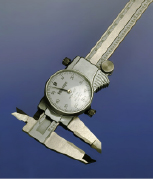
Figure 3-19.
Calipers can be digital (which automatically convert from millimeters to 1/64 inch to 1/1,000 inch), or analog like these (so you never need to worry about a dead battery).